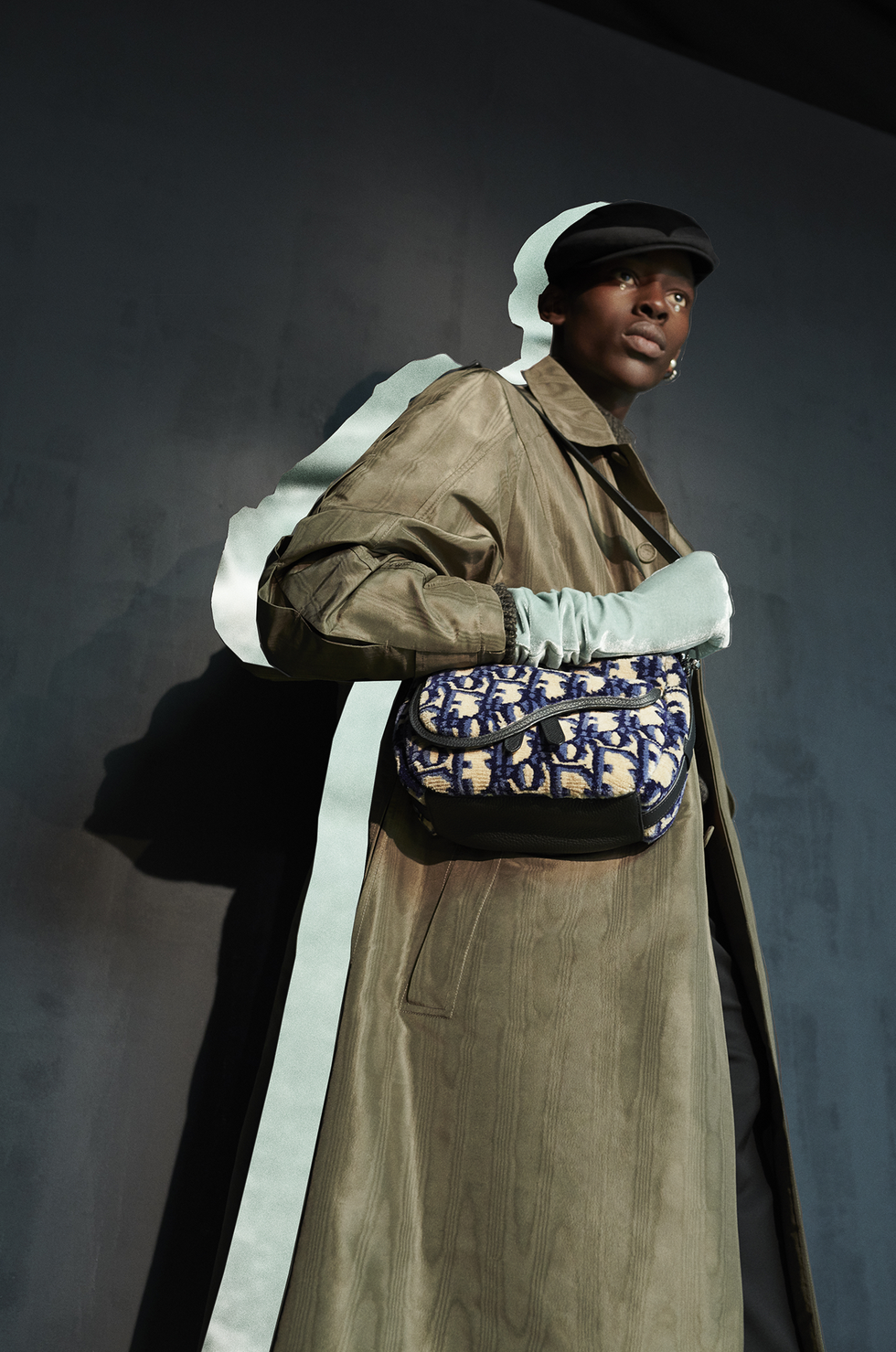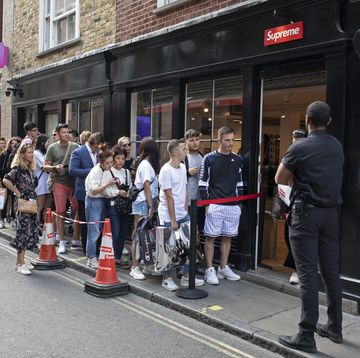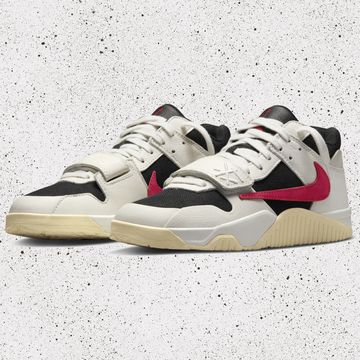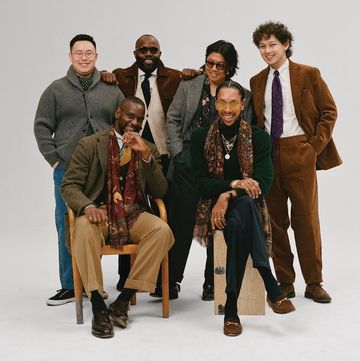“He was one of the pioneers,” says Kim Jones of the late Judy Blame. “He was just a really amazing, ground-breaking person. After he died, I wanted to do a tribute to him, in Paris. I wanted it to be like a couture show, for him. The kind of thing where there wouldn’t have been a single piece left on the rack, because he would’ve taken it all home.”
Jones’s autumn/winter collection for Dior is just that: a celebration of the legacy of Blame, the extraordinary British stylist, art director, jeweller, dandy, iconoclast and pop-culture provocateur, who died in 2018, at 58. Best known for his work with musicians, at crucial moments Blame styled and art-directed Boy George and Massive Attack, put Björk in mohair for the cover of her album Debut, and, most memorably and arrestingly, dressed Neneh Cherry for her 1989 hit, “Buffalo Stance”, in a mix of sportswear, oversize trophy jewellery and underwear as outerwear that continues to influence fashion, high and low, around the world, more than three decades on.
Blame was not only an interpreter of other people’s work. He made his own, too, most notably jewellery, which he fashioned from objects found on “mudlarking” expeditions, when he would pick up ephemera washed up on the banks of the River Thames: buttons, coins, badges, bottle tops. These would become broaches, earrings, pendants. “I’ll take a piece of rubbish and make it the chicest thing you’ve ever seen in your life,” he said, in his gravelly voice. His mantra: “Make something. Wear it. Cause trouble.” Some of those pieces would become embellishments for clothes made by Blame’s friend and collaborator Christopher Nemeth, often made from discarded linen postbags the designer found in the street. Nemeth, who died in 2010, is another of those who have inspired Jones. Five years ago, when Jones was at Louis Vuitton, he made a beautiful collection in homage to Nemeth. Blame was commissioned to make the jewellery: a luxury version of his earlier designs.
Jones first met Blame in a nightclub in London when the future Dior designer was, he reck-ons, 16 or 17. “He was very intimidating,” Jones remembers, “and I was very shy. But I went up and talked to him and he was extremely sweet to me. He was quite drunk. I was completely sober. I just remember that he wrote his number on the back of a business card. And he said, ‘If you want to come and assist me, you can.’ And I never did. I didn’t know what assisting was.”
As Jones’s stellar career gathered pace, through the launch of his own label, his time at Dunhill, his phenomenal tenure at Louis Vuitton, and now, at Dior, he never lost his respect for, or his connections to, the supremely influential generation of British designers and fashion creatives — stylists, photographers and more — that preceded his. “I wasn’t a really super-close friend of his,” Jones says, of his relationship with Blame. “But we were always in touch.”
A designer steeped in the history of 20th-century British art, culture and counterculture, Jones is speaking in the library of his extraordinary, art-filled glass and concrete house in west London, where he is surrounded by the work of his heroes, from first editions of Virginia Woolf novels and furniture by Roger Fry— he is a Bloomsbury Group supergeek — to paintings by Derek Jarman, clothes by Vivienne Westwood and much more besides.
It’s a Friday evening in late June. Shortly the weather will break, with a dramatic thunder-storm. For now it’s fiercely hot. Jones is wearing black shorts, a black Balenciaga T-shirt, Air Dior high-tops of his own design. He’s drinking Coke from a can. Elsewhere in the house, his team — surgical masks on, observing the two-metre rule — are working on Jones’s spring/summer 2021 Dior collection, a brilliant collaboration with the Ghanaian artist, Amoako Boafo, which is close to completion, and will a fortnight later be unveiled, to deserved acclaim, on video. But we are here to talk about Judy. Judy Blame was born Chris Barnes in Leatherhead, Surrey. After a peripatetic childhood, he moved to London, aged 17, at the height of punk, briefly retreating to Manchester beforere turning to the capital for good in 1978. He found a job in the cloakroom at Heaven, the legendary gay club by the Embankment. It was at Heaven, so the story goes, that he was renamed Judy, after Garland, by the glam rock couturier Antony Price, and Blame, because if you came out of the club in the early hours wearing someone else’s coat, it was probably Judy’s fault. He thought revellers should be sent home in clothes that suited them best, whether they arrived wearing them or not.
A key figure on the London scene of the Eighties — that fertile period for daring fashion, music, art, film-making and club culture, when the avant-garde and the underground crashed into mainstream consciousness — Blame was an influence on a generation of designers, notably Martin Margiela, as well as an early champion of Helmut Lang, and he went on to work with Marc Jacobs, John Galliano and Rei Kawakubo, of Comme des Garçons, among others.
His most formative period was his time as part of the fabled House of Beauty and Culture, a cult shop-slash-design collective in Dalston, east London, in the late Eighties. Jones takes up the story. “The House of Beauty and Cul-ture,” he says, “was Christopher Nemeth, Judy, John Moore, Richard Torry and Frick and Frack [Alan Macdonald and Fritz Solomon]. Frick and Frack made really amazing furniture, and lights and objects. Christopher Nemeth made clothes. John Moore made shoes; he died very young. Judy made jewellery. And Richard Torry made really amazing clothes, knitwear particularly, and then went on to become an incredible musician.
“It was almost like a commune,” Jones says,“a group of like-minded people who just did what they wanted to do.”
This is a time and place that Jones returns to frequently in his work, although he is too young to have been there himself. What is it about that moment that so entrances him?
“Just the amount of creativity that was coming out of London then, musically, fashion-wise, image-making,” he says. “I think it was a time where people were freer, they weren’t labelled. You look at those [Eighties] clubs, and how a small group of people could influence the world in a way that still lasts today. And it was never about money, it was about just creating. It was epic.”
As well as the House of Beauty and Culture, Blame was associated with Buffalo, the London fashion gang led by the late stylist Ray Petri, alongside photographers Jamie Morgan and Mark Lebon, who took the photos on this story. Their work, especially for the style magazines of that period, i-D and The Face, helped define the look of the Eighties.
Blame lived through — “survived” is how he put it — punk, new romanticism and acid house, a remarkable period in British pop culture. Does Jones see the conditions for these youth movements, and the creative ferment they inspired, occurring in London again?
“I think it’s a lot more difficult,” he says, “because you need money to live here now. You can’t get a room in a squat in central London like you could back then. It’s a very different time.”
That said, the joyful noise that Blame and his cohort created continues to echo through fashion and youth culture, and Jones sees their spirit, to an extent, in the group of designers, of whom he is the leading light, currently transforming the fashion establishment.
“I’m a collaborator in every sense, every day,” Jones says. “A lot of my friends are now heading up big houses. It’s great to see them doing so well.” He cites three: Virgil Abloh, of Louis Vuitton and Off-White fame; Matthew Williams, the designer of Alyx, lately announced as the new designer at Givenchy; and Yoon Ahn, of Ambush Design, who designs the jewellery for Jones’s collections at Dior. All have been championed by Jones, all have worked alongside him.
The Dior autumn/winter show took place in January, by the Place de la Concorde, Paris. In front of an audience including Kate Moss, Courtney Love and Robert Pattinson, models appeared wearing an abundance of items unmistakably inspired by Judy Blame: berets dec-orated with chains, coins and charms. Silver safety-pin earrings. Key chains. Gloves. There were also satin bomber jackets emblazoned with“DIOR”, a direct reference to the MA-1 flight jacket, the iconic Buffalo item.
But Jones’s influences are never limited to one. The spirit of Christian Dior himself, of course, hovers over each collection, and Jones, as ever, looted the archive at Dior, looking at the work of Marc Bohan, the longest serving but perhaps least heralded Dior designer. There’s an embroidered, sequinned jacket that appeared at the end of the show that Jones says was directly inspired by Bohan’s work, as was the paisley print seen on shirts and scarves. There’s also a newspaper print that nods to John Galliano’s time at Dior, Galliano having been inspired to use newspaper headlines and text by... Judy Blame. The references, like the clothes, are multi-layered.
In designing the collection, the question Jones asked himself and his team was: “What would Judy do, if he’d had that archive?” The collection is the answer they came up with.
Unlike friends and contemporaries from the club scene of the early Eighties — Boy George, John Galliano — Blame never became a house-hold name, though he was the subject of a retrospective at the ICA in 2016, about which, Jones remembers, “he was delighted”. Mainstream fame might not have suited him, anyway. (For that matter both Boy George and John Galliano, at various times, must have wondered whether it suited them.)
I spoke to Blame only once, in 2015, at a drinks party in London to celebrate Jones’s Christopher Nemeth collection for Louis Vuitton. Blame was funny and arch and irreverent and clearly enjoying himself. He was having a moment, and making the most of it. Thanks to Jones, he’s having another moment now.
Like this article? Sign up to our newsletter to get more articles like this delivered straight to your inbox
Need some positivity right now? Subscribe to Esquire now for a hit of style, fitness, culture and advice from the experts



















